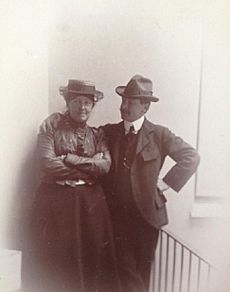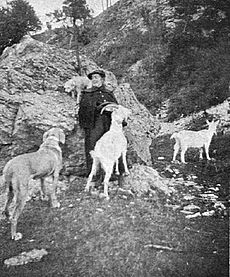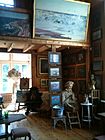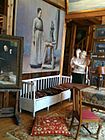Carolina Benedicks-Bruce facts for kids
Quick facts for kids
Carolina Benedicks-Bruce
|
|
|---|---|
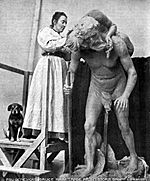
Carolina Benedicks-Bruce with L'obsédé
|
|
| Born |
Carolina Maria Benedicks
28 October 1856 Stockholm, Sweden
|
| Died | 16 February 1935 (aged 78) Visby, Sweden
|
| Nationality | Swedish |
| Known for | Brucebo |
|
Notable work
|
The wounded bather |
| Spouse(s) | William Blair Bruce |
| Awards | Mention Honorable, le Salon, Paris 1893 |
Carolina Maria Benedicks-Bruce (born October 28, 1856 – died February 16, 1935) was a talented Swedish sculptor. She first studied art in Sweden. Later, she moved to France to learn more and live in an artists' community. There, she met her husband, William Blair Bruce.
Together, they returned to Sweden and built their home, Brucebo, on the island of Gotland. This special place later became a nature reserve. Carolina also worked hard to protect old buildings. She supported women's right to vote and helped start the Swedish Women's Voluntary Defence Organization.
Contents
Early Life and Art School
Carolina Benedicks was born in Stockholm, Sweden, on October 28, 1856. Her family was wealthy. Her father owned a large ironworks. Many artists were in her mother's family. They helped Carolina develop her artistic skills.
She first attended an art school for women. Then, in 1881, she made history. Carolina became the first female student in the sculpture class. This was at the Royal Swedish Academy of Arts. She studied there until 1885.
Life and Art in France
While at the academy, Carolina met other female artists. These included Hilma af Klint. In 1883, she traveled to France with friends. They spent time in Paris. They also visited a Swedish artist community. This community was in Grez-sur-Loing.
After finishing her studies, Carolina went back to France. She became a student of the famous sculptor Alexandre Falguière. She also returned to Grez-sur-Loing. Many well-known Scandinavian artists gathered there in the 1880s. She met artists like Carl Larsson and Christian Krohg.
Carolina was different from most artists there. She was a single woman with a good art education. Her family was wealthy and supported her art. The artist community was mostly men with little money.
Her Sculptures and Other Works
Carolina Benedicks was mainly a sculptor. But she also created etchings and watercolors. Her sculptures show the French style of the late 1800s. Her paintings often featured landscapes and animals.
Her art was first shown in Paris in 1899. She presented her sculpture L'obsédé. In 1900, she won a bronze medal. This was at the Paris World's Fair. She also exhibited her work in Vienna.
When she made busts (sculptures of a person's head and shoulders), she used marble and bronze. One bronze bust was called Michel Angelo. It showed Michelangelo as a thoughtful, everyday person. She also made busts of other artists.
Many of her sculptures and sketches are still at Brucebo. These include L'obsédé (meaning "The Obsessed"). Another famous work is Baigneur blessé ("The wounded bather"). This sculpture won an award in Paris in 1893.
Personal Life
Carolina met the artist William Blair Bruce in France in 1885. He was not well-known or rich then. Carolina visited him in Canada with her uncle. They got engaged within a year. Her family did not approve of the marriage.
They returned to Europe in 1887. They got married in 1888. Their marriage was one of many between artists from different countries. These marriages happened because of the mixed artist community in Grez-sur-Loing. After marrying, they moved to Paris. They traveled around Europe to paint and study.
Brucebo: Their Artist Home
In 1899, Carolina and William decided to live on Gotland. They bought land north of Visby. This place became known as Brucebo. They started to rebuild and expand the houses there. Carolina had the money for the project. William was the main architect. They moved to Brucebo in 1900.
When William died in 1906, Carolina stayed at Brucebo. She continued her art. Brucebo became a lively place for artists, musicians, and scientists. Carolina was a kind host. She had three workshops at Brucebo. She also kept many animals, like cows, horses, and even monkeys.
Carolina was interested in self-sufficiency. This means growing your own food. She had big plans for the garden. She even brought seeds from France. She lived at Brucebo until she died in 1935. She had no children. In her will, she said Brucebo should be a place for young artists. In 1972, this wish came true. The Brucebo Fine Art Scholarship Foundation was created.
Working for Change
Carolina Benedicks-Bruce was a strong and unique woman. She cared deeply about social and political issues. She fought for women's right to vote. In 1911, she invited women's rights leaders to Gotland. About 40 delegates from different countries visited Visby.
She also worked to protect Gotland's history. She strongly supported saving the Burmeisterska huset. This was a 17th-century house in Visby. She also helped start the Swedish Women's Voluntary Defence Organization on Gotland.
Carolina was a member of the Väskinde school council in 1911. A year later, she joined the Väskinde Fruit Growers Association. In 1913, she became part of the Väskinde Municipality Council. She also gave money to help save old buildings. She supported childcare and orphanages.
Gallery
See also
 In Spanish: Carolina Benedicks-Bruce para niños
In Spanish: Carolina Benedicks-Bruce para niños


